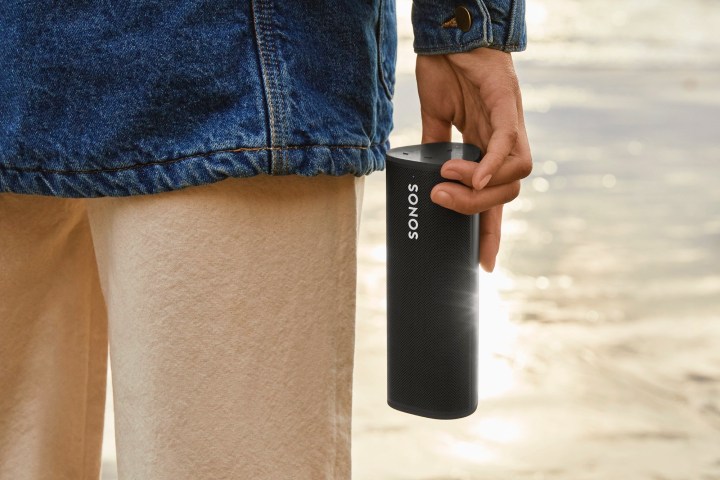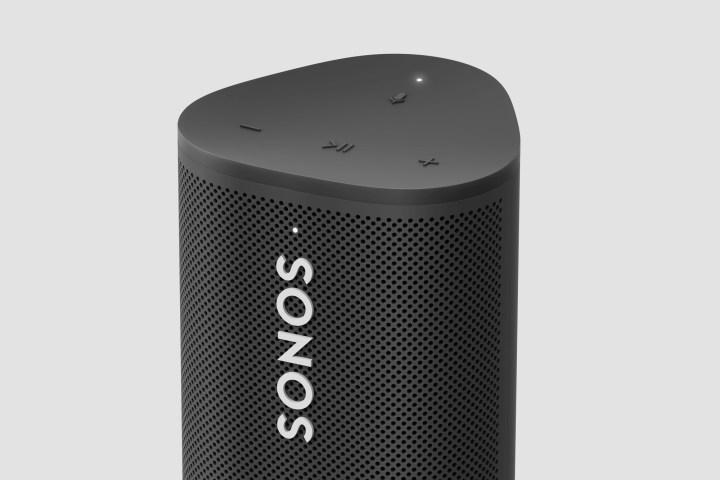
Sonos has just taken the wraps off its second portable speaker, the $169 Sonos Roam, which will be available in black or white when it hits retailers starting April 20, 2021. We had been expecting Sonos to deliver a mini version of its $399 Sonos Move, but thanks to better protection from the elements and wireless charging, the Roam is much more than a scaled-down Move. Here are all of the details.
Super small
We were impressed by the power and sound quality that Sonos had managed to pack into a rugged speaker like the Sonos Move, but our chief criticism was that despite being billed as portable, it was simply too big and heavy to be a true alternative to popular portable models like the UE Megaboom. The Sonos Roam, on the other hand, is ultraportable. At just under one pound and standing only 6.6 inches tall, the Roam is smaller and lighter than the $150 UE Boom 3.
The Roam doesn’t come with a carry strap, and there’s no way to affix one. Sonos says this was an intentional choice to keep the Roam looking as good as possible when at home. Conveniently, the Roam is slightly smaller than most refillable water bottles, and you should be able to carry it in any pouch or holder designed for these water bottles.
You can place the Roam sideways on its integrated rubber feet, or keep it standing vertically for a sleeker look.
Water and dust resistant

Needless to say, if you’re going to compete with today’s Bluetooth speakers, you need to withstand the same elements. With an IP67 rating, the Sonos Roam is fully dustproof (thus beach-proof) and can be immersed in one meter of water for up to 30 minutes without suffering damage. One thing to keep in mind if you’re planning on taking the Roam into the water: It may be waterproof, but it does not float, and the deep end of a pool could easily push the Roam past its IP67 protection.
Two drivers, two amps
Powering the tiny Roam are two custom drivers: A racetrack-style midwoofer and a tweeter, each with its own dedicated class-H amplifier. Sonos uses a more powerful version of this configuration on its Sonos One and One SL speakers, which should mean that the Roam will deliver very good, full-range sound. As with the company’s other products, there are adjustments for bass, treble, and loudness from within the Sonos app.
Real buttons

On the Roam’s top surface, you’ll find something that Sonos hasn’t included on its products in a while: Physical buttons. The reason for this is fairly obvious — touch controls are easy to tap accidentally and they’re not ideal for blind use. The Roam uses embossed-style buttons for play/pause and volume up/down. Without touch gestures, it’s likely they’ll work the same as the older Sonos products — a double-click on the play/pause button will skip forward a track, while a triple-click will skip backward.
S2-only

Speaking of the Sonos app, the Roam is only compatible with the newer S2 version of the company’s software. This means that if you’re still using the S1 version because your home has some of Sonos’ legacy products, you won’t be able to join the Roam to those speakers. You can, however, run the S2 version of the app at the same time as the S1 version, so it will be possible to manage the Roam on its own, or with newer Sonos products on an S2 network.
Unfortunately, as with the Move, Sonos has yet to make the S2 app work with the Roam when in Bluetooth-only mode. Instead, you’ll need to use dedicated third-party music apps like Spotify or Tidal, or the music stored on your phone, along with your phone’s Bluetooth connection.
Bluetooth and Wi-Fi
The Sonos Roam also improves on another Move feature: The ability to switch between Bluetooth and Wi-Fi depending on your location. With the Move, switching requires a press of a dedicated button on the back panel. The Roam performs the same switch automatically, sensing when you’re within range of your home’s Wi-Fi and when you’re not.
Technically speaking, it’s not really switching between these two wireless technologies — both are always active, which enables the Roam’s Bluetooth sharing feature: You can use the Roam’s Bluetooth connection as a quick and easy way to share audio from a phone (anyone’s phone) to all of your other Sonos speakers.
When using Wi-Fi, you can use two Sonos Roams as a stereo pair, but they won’t work as surround speakers for home theater setups, and they don’t work with the Sonos Sub. Unlike many newer Bluetooth speakers from UE, JBL, and Anker Soundcore, there’s no stereo-pairing or multispeaker option when the Roam is in Bluetooth mode, away from home.
As with the company’s most recent products, the Roam also works with Apple’s AirPlay 2 for direct streaming from Apple devices.
Choice of smart assistants

The Roam is also a smart speaker, and in keeping with Sonos’ tradition of being agnostic when it comes to third-party platforms, you can choose between Google Assistant or Amazon Alexa for your voice A.I. You can switch between these two options at any time, but they can’t run simultaneously on the same speaker. These voice A.I.s only work when the Roam is at home on your Wi-Fi network.
As with other Sonos smart speakers like the Move, Beam, and Arc, the far-field microphone array is hardwired to the mute button, so you can be relatively sure that the Roam will only be listening when you want it to.
The $180 UE Blast offers Amazon Alexa, but it costs more than the Roam and doesn’t give you the choice to use Google Assistant.
Automatic Trueplay
Sonos introduced Auto Trueplay tuning on the Move. This version of its room-based EQ adjustment automatically kicks in any time you reposition the speaker — with no need to wave around an iPhone. The Roam uses the same technology but makes it more useful. The Roam can use Auto Trueplay in any location, whether you’re using Wi-Fi or Bluetooth, and it continues to tweak that tuning even while stationary.
Wireless charging

The Move ships with its own charging cradle and, in a pinch, you can charge it via USB-C if you have the right kind of USB power adapter. But the Roam is way more versatile. It can charge from any USB-C power source, and it’s Qi-compatible too — simply stand the Roam on any charging mat and it will refuel.
Sonos doesn’t include a wireless charger with the Roam, presumably to keep the cost down, but you can buy one as a $49 optional accessory. Sonos’ Qi charger has the added benefit of magnetically latching to the bottom of the Roam to help avoid accidental misalignments while charging.
10 hours of power
If there’s one area where Sonos appears to have held back, it’s the Roam’s battery capacity. At 10 hours, you still get lots of juice for your outdoor adventures, but it’s a far cry from the 12 to 20 hours that we’ve seen from UE and other Bluetooth speaker brands. Still, Sonos appears to be doing everything it can to maximize the Roam’s stamina through the use of an auto-standby mode that kicks in whenever the speaker isn’t playing audio.
It can last 10 days in standby mode if needed.
Sound Swap
One of the Roam’s cleverest features is called Sound Swap. It lets you transfer a listening session from the Roam to another Sonos speaker, or vice versa, just by pressing and holding the play/pause button. It does this using ultrasonic signals. By initiating Sound Swap, the Roam triggers your other Sonos speaker to emit a high-pitched audio tone that humans can’t hear. The Roam listens for this signal using its microphone array and transfers its session to the speaker that it “hears” the best.
Sound Swap doesn’t work with all Sonos speakers. The Play:1 and Play:3 products aren’t compatible, and the Sonos Amp will only work with Sound Swap if you’re using it with Sonance-built Sonos in-wall, in-ceiling, or outdoor speakers. The feature might also experience hiccups if you transfer a Wi-Fi streaming session from a Sonos speaker to the Roam, and then take the Roam outside of the Wi-Fi network’s range.
The only question remaining now is how does the Roam sound? We’ll have that answer soon. Expect to see our full review of the Sonos Roam in the first week of April, before regular sales begin. If you’re already pretty sure the Roam is for you, pre-orders begin today on Sonos.com.
Editors' Recommendations
- JBL brings the boom with upgraded portables and party speakers for 2024
- B&O’s latest speaker is a love letter to aluminum
- Sonos Move 2: Sonos’ biggest portable speaker gets a big update
- JBL’s retro-style wireless speakers could spark serious envy among Sonos fans
- Android users are about to lose a handy Sonos feature



